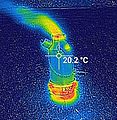Convection facts for kids
Convection is a way that heat moves. It happens when warm matter (like a liquid or gas) moves from one place to another, carrying its heat with it.
Think about how wind blows. Warm air moves from hot areas to cooler ones, making the wind. This wind can cool down a room if you open a window! Convection also helps move clouds, create ocean currents, and even warms your home with some types of heaters.
Contents
How Convection Works
Convection happens because of differences in temperature. When a liquid or gas gets hot, it becomes lighter and rises. When it cools down, it becomes heavier and sinks. This constant movement of hot rising and cold sinking matter creates a flow, which we call a convection current.
Natural Convection
Natural convection happens all by itself. Imagine a pot of water on a stove. The water at the bottom gets hot first. As it heats up, it becomes lighter and floats to the top. The cooler, heavier water from the top then sinks to the bottom to get heated. This creates a continuous loop, or current, that spreads heat throughout the water.
Forced Convection
Forced convection is when we use a device to make the fluid move. A good example is a fan. A fan pushes air around, even if the air isn't naturally moving. This forced movement helps to spread heat or cold faster. For instance, a fan can cool you down by moving cooler air towards you.
Convection Currents Around Us
Convection currents are everywhere! They are responsible for many natural events and how some machines work.
In the Atmosphere
Atmospheric circulation is a huge example of convection. The sun heats the Earth's surface, which then warms the air above it. This warm air rises, and cooler air rushes in to take its place, creating wind. This is how weather patterns and even big storms like thunderstorms form.
In the Oceans
Just like in the air, ocean currents are also driven by convection. Warmer water near the equator moves towards the poles, and colder water from the poles moves towards the equator. This helps to spread heat around the planet.
Inside the Earth
Deep inside the Earth, the Earth's mantle (a layer of rock) slowly moves because of convection. Hot rock from the core rises, and cooler rock sinks. This slow movement causes plate tectonics, which is how continents move and why we have earthquakes and volcanoes.
In Stars
Even giant stars like our Sun have convection! In their outer layers, hot gases rise and cooler gases sink, creating massive convection currents that help move energy from the star's core to its surface.
Related pages
Images for kids
-
Simulation of thermal convection in the Earth's mantle. Hot areas are shown in red, cold areas are shown in blue. A hot, less-dense material at the bottom moves upwards, and likewise, cold material from the top moves downwards.
-
An oceanic plate is added to by upwelling (left) and consumed at a subduction zone (right).
-
A fluid under Rayleigh–Bénard convection: the left picture represents the thermal field and the right picture its two-dimensional Fourier transform.
See also
 In Spanish: Convección para niños
In Spanish: Convección para niños










